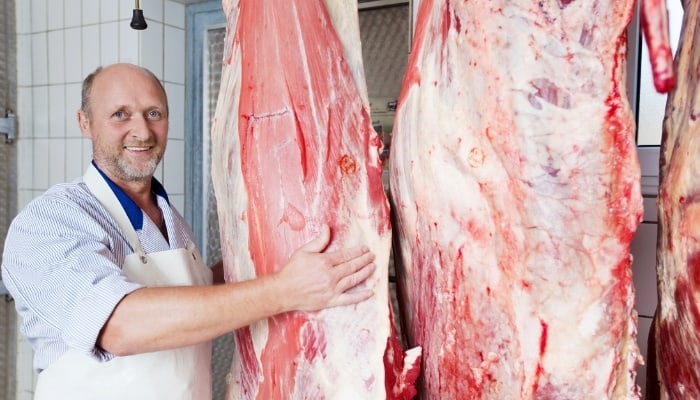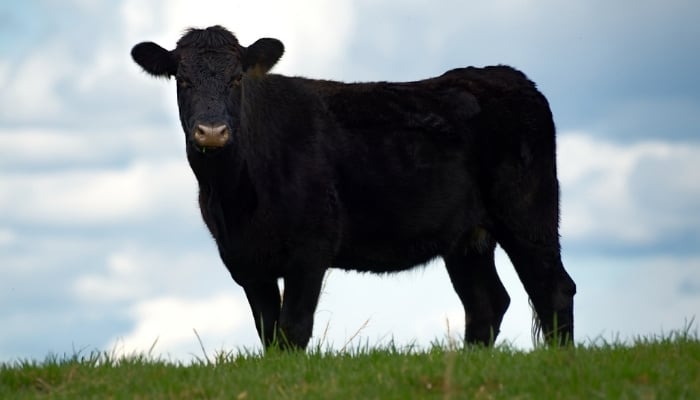It is a valuable task for any homesteader to learn how to raise beef for slaughter, as the average 1,200-pound steer (castrated male) yields enough meat to feed a large family for a year, with extra for potential profit according to this resource. However, what are the exact statistics involved in this process?
How much does it cost to butcher a cow? The overall costs of butchering a cow depend on your location, the cow’s weight, and how you want the meat processed. The combined killing and skinning fees can be $150 added to transport fees, which can be $1/mile, plus cutting and additional processing costs — all of which may add up to $1,000.
While the processing costs sound high on paper, we are talking, after all, about several hundreds of pounds of home-grown beef — not to mention the invaluable experience you’ll take away as a homesteader (even from merely observing the process).
Let’s look at the fees involved in butchering, the best cuts of meat to take, and more.
Average Costs of Butchering a Cow – What’s Involved
Each step of butchering a cow has its price from upfront fees for the cow itself, transportation to the butcher, killing, prepping the carcass, and preparing the meat in a certain way.
How Much To Expect To Pay Per Head of Cattle
Depending on the weight of the steer, you can expect to pay around $500 in total processing costs for 1,000-pound cows or up to $700-$1,000 for 1,400-pound steers.
This is assuming you’ve raised the cow yourself. Otherwise, purchasing a slaughter-ready male will set you back an additional $2,500-$4,000 per cow.
Breakdown of Fees Involved
Costs will, of course, vary depending on how you want your cow prepared and whether you choose to outsource certain steps or take them on with your own hands.
Here’s a look at the typical fees involved:
Transportation
These are the fees for a mobile butcher to come to you or the costs of transporting your steer or cow to a nearby slaughterhouse.
Skinning and Gutting
Some butchers may skin and gut the carcass free of charge, but this can vary depending on location, if you have specific preparation instructions, etc.
Saving the Hide
Farmers can choose to save the cowhide to be tanned and sold for leather. This involves skinning the carcass in a certain way.
Cutting and Wrapping
Fees to cut and wrap the meat are calculated per pound, and this tends to be lower in rural farming areas and higher near city regions.
Vacuum Sealing
Some cattle butchers vacuum seal/shrink wrap the meat as standard in their service, but others may charge extra (per pound).
Special Instructions
If you have specific instructions for the butchering process, such as making sausages, jerky etc., you best believe this costs extra time and money!
Live Weight vs. Hanging Weight
Live weight refers to the living cow’s weight before butchering (1,200 pounds on average).
A cow’s hanging weight refers to the total weight once the carcass has been stripped of inedible parts, hide, blood etc., which accounts for around 60% of the live weight.
How Much Meat From Hanging Weight?
Depending on how long the carcass has been hung to age and which cuts are taken, a typical 1,250-pound steer yields over 500 pounds of meat, meaning you’ll take home roughly 45% of the cow’s live weight.
Total Time Involved in Butchering a Cow
It can typically take around 4 to 6 weeks from the beginning of the slaughtering process with the arrival of the live cow until the meat is properly prepared and ready to take home (or be distributed to supermarkets).

What Cuts To Get When Butchering a Cow
At the start of the slaughtering process, main or primal cuts of meat before being divided into sub-primal cuts to be further broken down for retail beef cuts. The primal cuts are:
- Rump – the top end of the hindquarters
- Round – hindquarters, including the back leg
- Shank – from the thigh
- Flank – along the belly
- Sirloin – rear loin
- Short loin – directly ahead of sirloin
- Rib – between the sixth and twelfth rib
- Plate – the underbelly
- Chuck– the front quarter region (top of the neck)
- Brisket – beneath the chuck
Exactly what cuts to order is entirely up to you and will likely depend on your family’s preferences. Consider how many steaks versus roasts and how much hamburger and stew meat you’d like.
What Age Are Cows Slaughtered?
Steers are ready for butchering when the brisket has filled out and fat rolls can be observed at the tail head. Depending on their diet, this can come at 1 ½ years old or a little over 2 years.
Best Time of Year To Butcher a Cow
Fall is usually the most advantageous time for butchering since the cooler weather helps with the meat cooling and curing process. Prior to winter is when beef cattle are at their fattiest and most tender too.
Can You Butcher Your Own Cow?
Yes, it’s legal for you to butcher and process your own cow, but you must possess the training to ensure the animal will be slaughtered humanely.
You’ll require a basic set of equipment, an appropriate prep area, at least one helper, etc., and factors like the weather need to be taken into account to prevent spoilage.
Related Questions:
How Long Does It Take To Raise a Cow for Slaughter?
Purely grass-fed cows normally take around 26 to 28 months to raise for slaughter, while cows reared on grain will take less time to raise to slaughtering age at around 14 to 18 months.
A combination of high-quality forage and rich grain should see calves gain weight fairly rapidly.
How Long Does It Take To Butcher a Cow By Hand?
The total time to butcher a cow by hand will depend on the size of the cow and the cuts required, but generally, it can take between 2 and 4 hours to slaughter, skin, and cut up a cow carcass depending on skill level.
An experienced cattle butcher may take under an hour by comparison.
Conclusion
In summary, it can cost between $500 and $1,000 in processing costs to butcher a cow that you have raised for beef (and thousands more if you choose to purchase a cow for slaughter).
With factors ranging from the cow’s weight and transportation to the choice of cuts, it’s tricky to estimate individual butchering costs, but we hope you now have a rough idea of what to expect.

